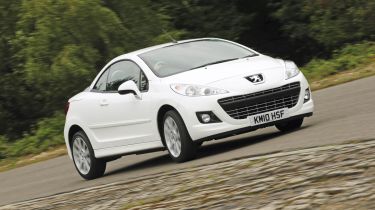Peugeot 207CC
Pioneering folding hard-top still sets the supermini standard
As the CC bears such a close resemblance to the standard 207, it can’t match the new Wind for image. But it still has plenty of style. The car has coupé-like dimensions, which is down to Peugeot’s own design team – it brought development in-house, after Pininfarina penned the 206 CC.
As with its predecessor, the 207 CC features a two-part roof which has an unwelcome impact on the packaging. The windscreen extends a long way back over the cabin, reducing headroom – it’s all too easy to bang your head when climbing in. It’s not much better at the back, either, with the deck housing the folded roof having a detrimental effect on styling.
What’s more, with the metal lid stowed, the boot space is shallow and awkward to access. The 187-litre load bay trails the Wind by a significant 83 litres on capacity, although with the roof in place, luggage space expands to a generous 449 litres.
The mechanism itself is fully automated, unlike the Renault’s flip-top design. But as the folding operation is so complex, it takes more than twice as long, at 25 seconds – you wouldn’t risk it at a set of traffic lights.
The four-seater layout doesn’t give the 207 CC’s interior a big advantage, as the rear seats are so upright and tight for legroom, even children will struggle to fit in. The driving position isn’t bad, though, and unlike in the Wind, you get reach adjustment on the steering wheel. As with other 207s, the upper part of the dash is modern and attractively designed, but the plastics used lower down in the cabin look and feel cheap.
Used - available now

2024 BMW
2 Series Gran Coupe
20,431 milesAutomaticPetrol1.5L
Cash £22,099
2022 Volvo
S60
15,501 milesAutomaticPetrol2.0L
Cash £23,599
2021 Mercedes
A-Class Saloon
9,754 milesAutomaticDiesel2.0L
Cash £22,499
2023 Honda
CR-V
14,943 milesAutomaticPetrol2.0L
Cash £27,060Still, that doesn’t stop the Peugeot from triumphing in terms of overall interior quality. It feels like a more upmarket product… at least until you pull away. The 207 CC doesn’t resist body flex as well as its stiff new rival, with movement to be felt around the A-pillars – as a result, the ride on rough surfaces isn’t great.
It isn’t as well damped as the Renault, with bumps and imperfections being felt through the steering and suspension. The chassis is a mixed bag, because while it’s not as rigid as the Wind’s, the Peugeot offers more responsive and communicative steering. Unfortunately, the slack shifting six-speed manual box takes the edge off the driving experience, and the brakes don’t have the firm bite that makes the Wind so reassuring.
The Peugeot’s THP engine is a real plus point, though. It’s smooth, refined and delivers strong performance. The 156bhp unit has a useful 25bhp power advantage over its rival, so the car was quicker during our track tests, while its low-down punch makes for relaxed progress.
The folding metal hard-top is the CC’s unique selling point, but it demands compromises in terms of rigidity and practicality – and that gives the Wind, with its simple flip lid design, the upper hand. Will this prove decisive in our verdict?
Details
Chart position: 2
WHY: The 207 CC is one of the established players in the coupé-cabriolet sector. With a loyal fanbase, it’s a strong rival for any newcomer.







